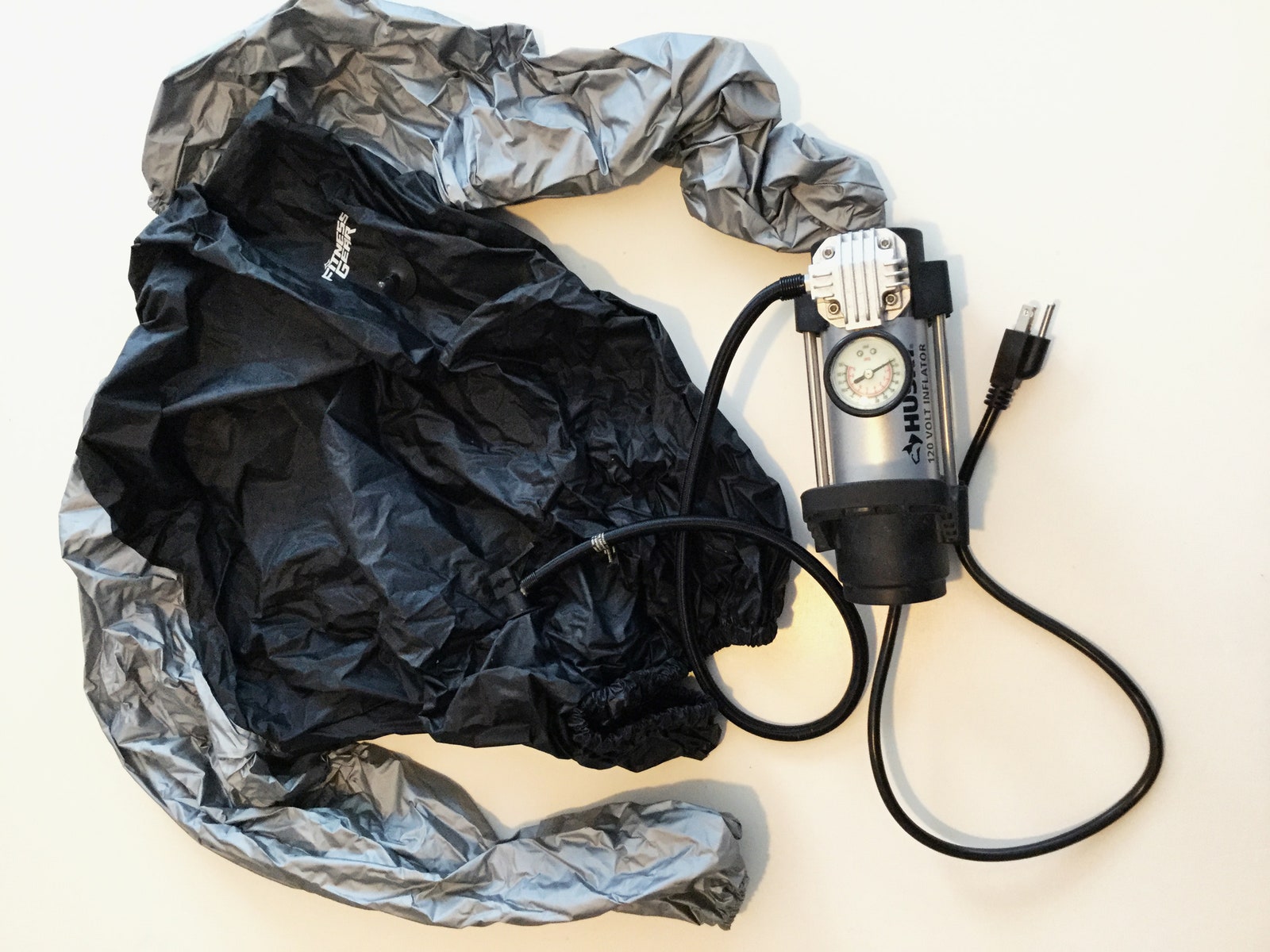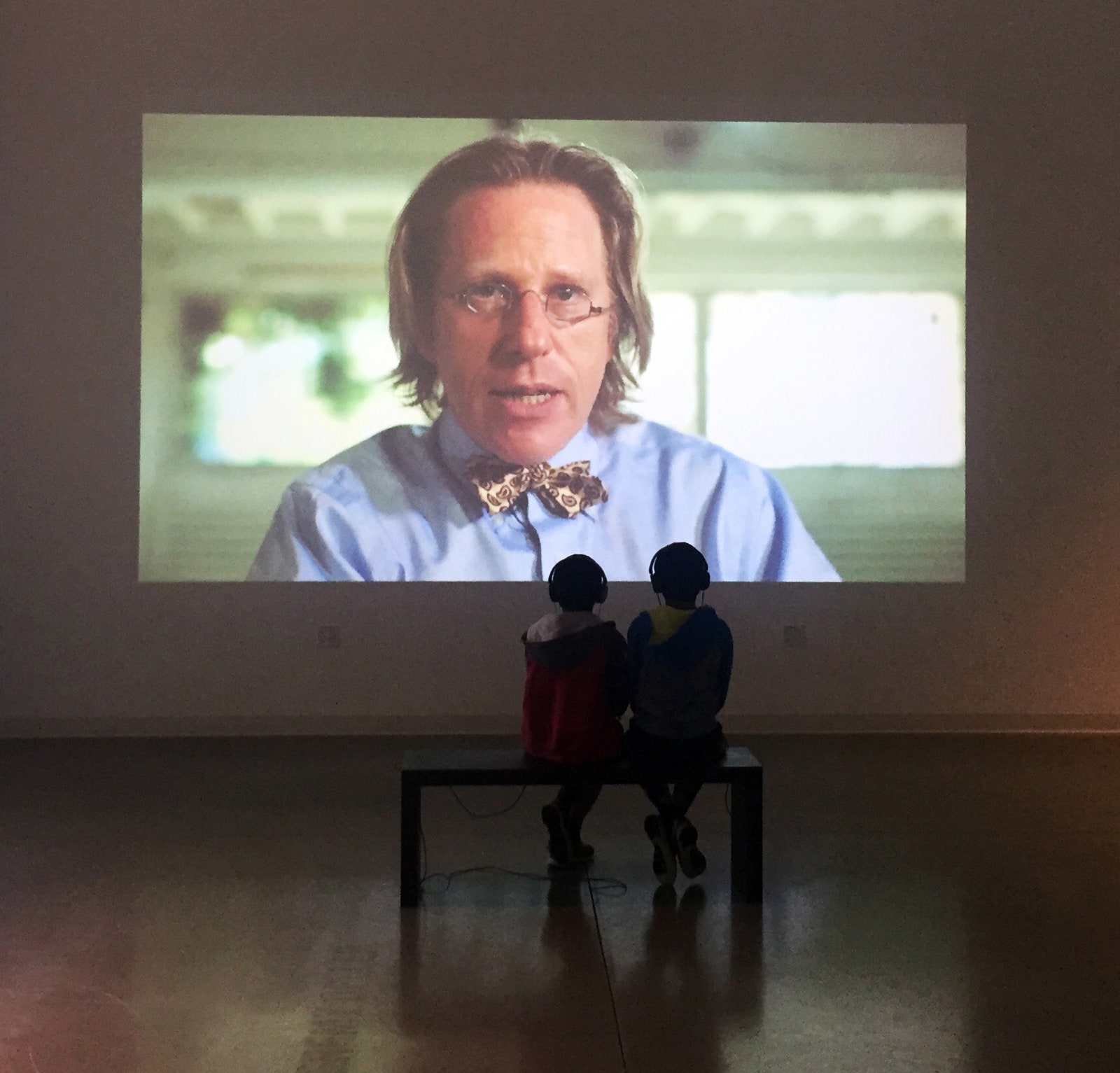FOR TWO DECADES, the artist and experimental philosopher Jonathon Keats has been producing works that explore how we humans perceive ourselves and our place on this planet. He does this through books and exhibits, but mostly through oddball inventions. A camera that takes a single exposure over the course of 1,000 years, so we can visualize the abstract concept of climate change. A clock that uses an Alaskan river to measure time. A pornographic film for plants that features “uncensored pollination.”
Keats’s latest invention is the Pheromonophone, an inflatable suit with tubes coming out of it that records your body odor onto a carbon capsule. You then can ship that capsule to a lucky recipient who inhales the air pumped through the capsule to sample your unique nimbus. It sounds disgusting, and probably is—thankfully, Keats has only built one prototype. The prankish device is a rumination on our desire for deeper, more visceral communication with our distant friends. Think about it: How much better would Zoom calls be if you could not only see and hear but also smell the other person on the screen?
Keats and his olfactory invention are the subjects of a new Audible-exclusive audiobook being released today, The Curious Case of the Pheromonophone. Author and narrator Michael Epstein follows Keats around Silicon Valley as he demos the foul fabrication for wide-eyed investors and jaded engineers. The resulting conversations expose more about how Silicon Valley perceives itself than the marketability of the silly smell-tech. But that’s sort of the point.
This is where I must tell you that Keats is a frequent WIRED contributor, and that when he does write for us, I often serve as his editor, critiquing his ideas and shaking him down for copy with angry emails. For some reason, he still wanted to talk to me about the Pheromonophone and the audio journey that resulted from its unboxing. Our interview (the Zoom connection thankfully could only support picture and sound, not smell) has been edited and condensed.
Jonathon Keats: If you think back to 1960s sci-fi, people in those stories are able to have video calls. It seemed exciting, but when we finally got there, a lot of people were underwhelmed. People have these teleconferences, but nobody feels like they’re really connecting.
So, as I often will do, I started looking back. I looked to the history of communication, past Alexander Graham Bell and Samuel F. B. Morse, all the way back to the Neanderthals and Homo heidelbergensis. They would communicate primarily by smell, by some sort of pheromonal communication. We’ve had this form of communication all along without even realizing it. In fact, we’re currently doing everything we can to try to cut it off with various sorts of deodorant. I thought maybe this was a missing link, the missing part of how people might be able to better connect.
I made a working prototype of the Pheromonophone. I bought a suit on eBay that is used for exercising, so that you sweat more and therefore lose weight. It blows up on your body, and the air that runs through the suit is captured in a pellet of activated carbon. That pellet is then sent to somebody else. They put on a face mask, and by pumping air through the pellet and into the mask, they are able to get a whiff of your pheromones that have been captured in the carbon pellet. All of this was made using cheap hardware materials because I didn’t have much of a budget. I was really working in the mid two figures.
WIRED: I guess the pheromonophone is sort of an augmented reality device, then?
JK: Ultimately, where we ended up was with the opportunity to do a demo with Adobe. Adobe had a new augmented reality app, and they were interested in other ways that augmented reality might be used in the future. I realized that’s what we need most in this world—not necessarily just a way to augment our own reality, but to figure out how to create a collective space that is augmented. A space where we are able to connect not only with other humans, but with all other beings. Ultimately, the bigger question that is begged by the smaller question of how you fix telecommuting is how you really allow for a sort of genuine connection at a distance.
WIRED: One of the joys of the audiobook is that we get to sit in on the tech demo for the Pheromonophone. I’ve sat through hundreds of consumer tech demos, and I was laughing out loud hearing you give yours. You’re wearing a rubber suit with tubes coming out of it, there’s a gas mask on the table. It uses theater in the same way most tech demos do, even if the people giving the demos won’t admit that.
So what I am trying to do is demonstrate not only a product, but to demonstrate the possibility of taking some sort of a leap into the unknown. The Pheromonophone is outlandish, and the prototype I created is absurd. Yet I wanted to take the opportunity seriously, and to give a demo that is manifestly alternative to the usual product demo in order to disrupt it. So by using the theatricality of Silicon Valley and being the salesman for this product, there’s a way in which I could take greater risks and ask bigger questions.
WIRED: What Michael [the audiobook’s author and narrator] ultimately learns is that the Pheromonophone prototype works, but that it delivers an experience that most people wouldn’t want to buy. It’s literally a stink suit. It really made me think of so many products that we see where it’s like … nobody asked for this. Everything from the Shake Weight to digital picture frames with cameras on them, like Facebook Portal. Why did you make this? Did anyone ever ask: Just because you could make this, does that mean you should make this?
JK: I think that is an essential point about Silicon Valley, that problems are invented for the sake of finding a solution. The selling of the product then ultimately only serves the purpose of keeping the company alive and making money for investors. I think that that is damaging at best, and catastrophic at worst, and really the source of so much landfill in physical terms. Products take up mental space too. Our lives are so cluttered with technology we don’t need that it all becomes a distraction rather than really serving to make us better people.
Telecommunication is glitchy. The resolution isn’t sufficient enough to be convincing. No matter how many leaps you make in quality and clarity, there’s still going to be something unsatisfactory about it. The only way to ever be able to understand what’s unsatisfactory about it is to step back from the technology and look at us as a species, to look at us as a planet and ask what is lacking. So the problem that is in need of being addressed by Zoom or by Skype—or by Google, which apparently also is doing this, though nobody seems to notice—is not the problem of improving a glitch or even trying to figure out how to do video better. Telecommunication is still going to fall short.
There are so many reasons why the Pheromonophone is a terrible idea. But I think it does take us down a road that iterative problem solving will not: It opens up the conversation that we need to be having. That is, the conversation about what we need.
WIRED: I went to an art exhibit this February where you presented a meticulously cataloged collection of humanity’s creations and possessions, and the subtext was that we make a ton of worthless shit we don’t need. The exhibit was funny, but in the end it was a warning that we’re choking on all this crap we’ve churned out. One could argue that the funny Pheromonophone has a similar warning. Communication has a comfort limit, and our craving for new forms of intimacy may lead us to a place that we don’t actually want to visit. Do you really want to breathe somebody else’s body odor? I hope not.
JK: I think that in order for us to figure out what we want, we need to start prototyping tomorrow—and doing so with approaches that are as broad and as diverse as possible. This isn’t a matter of science fiction set 500 years in the future. This is a matter of us needing to take responsibility for our future now.
So I am interested above all in exploring the space of possibility, and in bringing others into that process with me in a way that does not insist on any one future, but insists on the need for all of us to address this together. The future of us as a species remains uncertain and unfixed, and it only becomes fixed at the point when we lazily set aside our own responsibilities and leave it to Silicon Valley to decide what it is that we want.
The situation right now is that the pandemic is potentially a reset in some ways, where people are realizing what they want. It is an opportunity for all sorts of new technology to allow for social distancing on a permanent basis in a much stronger way.
WIRED: You’re the main character of this audiobook, so it serves as sort of a profile. It’s not the first time that you’ve been profiled right?
JK: I’ve been profiled before by other publications, by some documentaries. There’s also a monograph about my work that’s coming out later this year from the Anchorage Museum and the German art book publisher, Hirmer. It’s an attempt to contextualize my work in the art world historically. That is something that has not really happened thus far because I operate at the fringe of everything, including the art world. The art world is so open-ended in terms of what it is and what it does that anything goes. Nobody really is quite sure what art is anymore, and therefore I can get away with all sorts of things.
Source: The Pheromonophone Lets You Reach Out and Smell Someone | WIRED

















